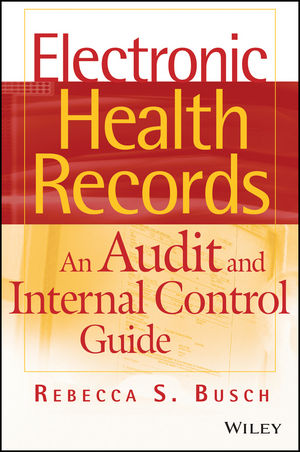Electronic Health Records: An Audit and Internal Control GuideISBN: 978-0-470-25820-0
Hardcover
256 pages
August 2008
 |
||||||
About the Author.
Acknowledgments.
Introduction.
Chapter 1. Market Background.
E-Health.
How is Electronic Information Created?
Information Technology Considerations.
How is Health Information Created?
Review of Primary HCC Market Players.
Patients.
Providers.
Third Party Vendors.
Payers.
Review of HCC Secondary Market Players.
Major Initiative for E-Health.
Audit Implication Overview.
Chapter 2. Industry Application.
Public Uses.
Private Uses.
Information Continuum.
Market Standards and Initiatives.
Agency for Healthcare Research and Quality.
Health Level Seven.
Certification Commission for Healthcare Information Technology.
Department of Defense Records Management Program.
Association of Records Managers and Administrators.
Audit Implication Overview.
Chapter 3. Impact of E-Health on Case Management.
Financial Picture.
Hospital-Based FCM Application.
Background Information and Provider Perspective.
Problem: Getting Paid Correctly for Services Provided.
Findings.
Additional Findings.
Summary.
Consumer-Based FCM Application.
Market Problems: The Industry as It Operates Today.
Consumer FCM Model.
Healthcare Portfolio Application.
Virtual Case Management.
VCM Payer Model.
VCM Patient Model.
VCM Hospital Model.
VCM Physician Model.
VCM Allied Health Services.
VCM Nontraditional Health Services Model.
VCM Other Business Services Model.
Audit Implication Overview.
Chapter 4. Data in an E-Health Environment.
Data Library.
Data Intelligence.
New Data.
More New Data.
Processed Data.
Data Warehouse.
Audit Implication Overview.
Chapter 5. Algorithms.
Background.
Understanding Algorithms.
Data Elements.
Case Study.
Algorithm Selection
Auditor Implication Overview.
Chapter 6. Data-Driven Health Decisions in an E-Health Environment.
Knowledge Models.
Primary Healthcare Continuum.
Secondary Healthcare Continuum.
Information Continuum.
Third-Party Vendor Knowledge Model.
Knowledge Models For White-Collar and Organized Crime.
Sample Identity Theft Case.
Medical Identity Theft.
Medical Identity Theft – Definition.
How Medical Identity Theft Occurs.
Damages To Primary Victims.
Medical Identity Theft From A Consumer Perspective.
When The Consumer Is Not Aware.
When The Consumer Is Involved.
When An Individual Wants Products Or Services.
Damages To Secondary Victims.
Medical Identity Theft From An Entity’s Perspective.
Auditor Considerations.
Sample Fraud Case.
Sample Pharmaceutical Fraud Case.
Audit Implication Overview.
Examples Of Worldwide Activity.
Chapter 7. Analytic Tools and Audit Checklists.
E-Health And Healthcare Business Processes.
Patient Business Process.
Problem #1: Financial Case Management Advocacy.
Problem #2: Clinical Case Management Advocacy.
Provider Business Process.
Problem #1: Lack Of Electronic Internal Controls.
Problem #2: Lack Of Internal Controls With User Identity.
Problem #3: Lack Of Internal Controls For Services Provided And Charged.
Payer Business Process.
Problem #1: Use And Loss Of Health Information – Handling Subcontracted Vendors.
Problem #2: Lack Of Insurance – Processing Fraudulent Claims For Enrolled Beneficiaries.
Plan Sponsor Business Process.
Problem #1: Employee Working Environments.
Problem #2: Employer Increase In Healthcare Expenditures.
Third-Party Vendor Business Process.
Problem: Increase In Pharmaceutical Expenditures.
Audit Implication Overview.
Chapter 8. Electronic Health Records.
Current E-Health Offerings.
Market Evolution.
E-Health Content Standards.
E-Health Offering Vulnerabilities.
Audit Implication Overview.
Chapter 9. Healthcare Portfolio.
Health Infomediary Support.
PHR Attributes.
Future Considerations.
Major Market Activity.
Audit Implication Overview.
Chapter 10. Conclusions.
Market Overview.
Market Standards.
Market Conflicts.
Market Intelligence.
Market Audits.
Market Directions.
Consumer Response to PHRs.
Audit Implication Overview.
Index.



